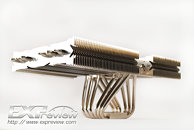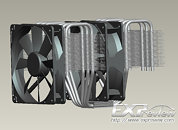- Joined
- Oct 9, 2007
- Messages
- 47,538 (7.47/day)
- Location
- Hyderabad, India
| System Name | RBMK-1000 |
|---|---|
| Processor | AMD Ryzen 7 5700G |
| Motherboard | ASUS ROG Strix B450-E Gaming |
| Cooling | DeepCool Gammax L240 V2 |
| Memory | 2x 8GB G.Skill Sniper X |
| Video Card(s) | Palit GeForce RTX 2080 SUPER GameRock |
| Storage | Western Digital Black NVMe 512GB |
| Display(s) | BenQ 1440p 60 Hz 27-inch |
| Case | Corsair Carbide 100R |
| Audio Device(s) | ASUS SupremeFX S1220A |
| Power Supply | Cooler Master MWE Gold 650W |
| Mouse | ASUS ROG Strix Impact |
| Keyboard | Gamdias Hermes E2 |
| Software | Windows 11 Pro |
Among the sea of tower-type CPU coolers which are the same old tripe packaged and colored differently, few companies are actually investing in innovation, one of them is Prolimatech. The company is working on two new yet-unnamed CPU coolers specifically designed for socket LGA2011 motherboards, one has already taken shape, the other is still in its CGI form.
The first one (first two images below), appears to be an leaner, fitter evolution of the Prolimatech Genesis. While the Genesis uses a dual-independent fin-stack design in which one stack propagates perpendicular to the plane of the motherboard while the other propagates parallel to the plane, on this new design, both stacks propagate parallel to the plane, in opposite directions, and both being dissimilar in size.




Fans are to be strapped onto both stacks, which perform top-flow ventilation. The larger fin stack of the two ideally hovers over the memory area of the motherboard that's east of the socket, while the smaller one over the memory area west of it. It becomes a tight squeeze for things west of the socket, and this is probably why this stack is smaller. Heat is conveyed to the two by six heat-pipes, which pass through the base.
The second cooler (last two images above), has a slightly more exotic shape, in which the heat pipe take three sharp U-turns, in the long-arms of each of these U-turns is an aluminum fin stack, and the CPU base is in the center. Unlike the other cooler design, this cooler has a side-flow ventilation. The aluminum fin stacks don't propagate all the way down, to make room for the memory areas below. As for the ventilation, a single 120 mm fan can be attached in the central portion, more fans can be attached to the aluminum fin stacks at convenient locations. There is no word on when (or if) this design will materialize.
View at TechPowerUp Main Site
The first one (first two images below), appears to be an leaner, fitter evolution of the Prolimatech Genesis. While the Genesis uses a dual-independent fin-stack design in which one stack propagates perpendicular to the plane of the motherboard while the other propagates parallel to the plane, on this new design, both stacks propagate parallel to the plane, in opposite directions, and both being dissimilar in size.




Fans are to be strapped onto both stacks, which perform top-flow ventilation. The larger fin stack of the two ideally hovers over the memory area of the motherboard that's east of the socket, while the smaller one over the memory area west of it. It becomes a tight squeeze for things west of the socket, and this is probably why this stack is smaller. Heat is conveyed to the two by six heat-pipes, which pass through the base.
The second cooler (last two images above), has a slightly more exotic shape, in which the heat pipe take three sharp U-turns, in the long-arms of each of these U-turns is an aluminum fin stack, and the CPU base is in the center. Unlike the other cooler design, this cooler has a side-flow ventilation. The aluminum fin stacks don't propagate all the way down, to make room for the memory areas below. As for the ventilation, a single 120 mm fan can be attached in the central portion, more fans can be attached to the aluminum fin stacks at convenient locations. There is no word on when (or if) this design will materialize.
View at TechPowerUp Main Site






